Dual Structures in Fritz Leiber’s Fafhrd and the Gray Mouser Stories and Robin Wayne Bailey’s Swords against the Shadowland
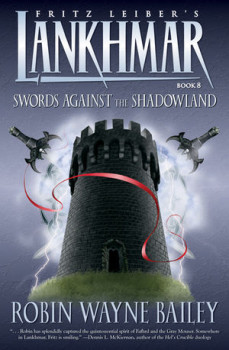 Recently I completed my reading of all of Fritz Leiber’s Fafhrd and the Gray Mouser stories. After I had put down the second or fourth collection (this depends on how you approach the editions from White Wolf, which collected the books doubly in single volumes, and these are the publications with which I began my survey), I made some faintly denigrating comment on Goodreads (if I remember it correctly), something about the quality of these stories being like flies caught in amber. This was a metaphor for Leiber’s soupy, languid, highly embellished prose style.
Recently I completed my reading of all of Fritz Leiber’s Fafhrd and the Gray Mouser stories. After I had put down the second or fourth collection (this depends on how you approach the editions from White Wolf, which collected the books doubly in single volumes, and these are the publications with which I began my survey), I made some faintly denigrating comment on Goodreads (if I remember it correctly), something about the quality of these stories being like flies caught in amber. This was a metaphor for Leiber’s soupy, languid, highly embellished prose style.
But a year or so later, as I got to the end of The Knight and Knave of Swords and then the termination of Swords and Ice Magic, I found that I had really begun enjoying these stories. I had even begun to admire the writing style. So I bought, without question, Robin Wayne Bailey’s Swords against the Shadowland out of interest to see who possibly could be so foolish as to try to meet Leiber on his own brilliant terms.
Before I get to a review of Leiber and then, specifically, to Bailey, I want to detail the kind of place I come from. As I become a regular contributor to Black Gate, I realize that there are quite a number of books that I really should have read while I was growing up. Now, I’ve read a lot of fantasy. That will be apparent. But sometimes I pick up a new volume, open the cover, begin reading, and ask myself, “Why didn’t I read this twenty-five years ago?” One of the answers might be because of my intense snobbishness, a youthful shortcoming that I slightly touched on last entry. Another reason is because, at the beginning of eleventh grade, I artificially arrested the sheer volume of my high fantasy reading by consciously “growing up” and turning my back on the genre in preference for established “literary” pursuits. But also, as I cast my memory back through the years, I’m coming to believe that I didn’t read a lot of these works then because a lot of these weren’t all that visible.
What was visible, in my suburban library in the late 80s and early 90s? Tolkien imitations, of course, and I must confess that these are precisely, at the time, what I wanted to read. I readily admit to having been (and in some cases, still being) one of those dronish zealots who just wanted Tolkien, more Tolkien. Tolkien. Tolkien. Tolkien. As I have grown and read some of the least slavish imitations of Tolkien, I have become aware of a variety of fantasy structures. The Tolkienian structure, I’m sure most of you don’t need to be told, is roughly as follows: a race of peaceful, pleasant folk (not Hobbits, because that would be copyright infringement), usually some breed of shortish Man, live in an isolated region (usually located, conspicuously enough, in the West). Into this region intrudes some Evil force. Some common, unlikely bloke realizes that he (sometimes she?) has a destiny either to destroy something or to find something and usually to battle something way, way overmatched for him or her. This person sets forth, gathers a company of helpers, travels through various interesting regions peopled by interesting sorts, and has many episodic adventures.
Of all of Tolkien’s laudable contributions to the genre, this might be his greatest – the geography and geology of a fantasy world, the narrative moves, and the company of adventurers. At a glance, a number of high profile fantasies conform to this structure. The most famous is Terry Brooks’s The Sword of Shannara, but also Terry Goodkind’s Wizard’s First Rule and Robert Jordan’s The Eye of the World.
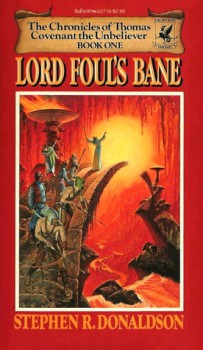 As a young person, I read Brooks. I enjoyed him, even though, even in fifth or sixth grade, I recognized that his work was shamelessly derivative. I thought, judging by the Darrell K. Sweet cover art, that Stephen Donaldson’s Lord Foul’s Bane would be just my thing, but I never read another in the series. As I said last time, I read some TSR books. I also read and reread The Chronicles of Narnia (I had been introduced to these, before Tolkien, by my third grade teacher). I read Lloyd Alexander, Ursula K. Le Guin (Earthsea was a “trilogy” at the time), and Madeline L’Engle (though not much more than A Wrinkle in Time).
As a young person, I read Brooks. I enjoyed him, even though, even in fifth or sixth grade, I recognized that his work was shamelessly derivative. I thought, judging by the Darrell K. Sweet cover art, that Stephen Donaldson’s Lord Foul’s Bane would be just my thing, but I never read another in the series. As I said last time, I read some TSR books. I also read and reread The Chronicles of Narnia (I had been introduced to these, before Tolkien, by my third grade teacher). I read Lloyd Alexander, Ursula K. Le Guin (Earthsea was a “trilogy” at the time), and Madeline L’Engle (though not much more than A Wrinkle in Time).
Why didn’t I like Donaldson? I should have liked him. Lord Foul’s Bane was chock full of cool fantasy stuff. There was just one problem: I was a young boy enamored of Tolkienian virtue – truth, honor, courage, respect, even the value of gardening. And Thomas Covenant was the antithesis of all these qualities. He was an anti-hero. It is terribly difficult to get an idealist young boy to believe that even someone dying of leprosy could behave and treat a beautiful fantasy world in the way that our anti-hero, Thomas Covenant, did. Sure, Covenant believed that he was in the grip of near-death, narcotic dreams. But the boy who was me didn’t believe that even dreams were a justification for vice and villainy.
Of course, that boy was just a boy, and didn’t have the slightest inkling of what true pain and suffering is and what it can do to someone’s soul, spirit, and ideals.
So this shows that, even if I had discovered something like Robert E. Howard’s Conan or Fritz Leiber’s Fafhrd and the Gray Mouser, I might not have been ready for it. I might have rejected it. My young, absolutist, idealist boy brain just might not have been able to comprehend a hero who was only motivated by self-interest, who only wanted to drink and brawl and sleep with women (well, maybe I could understand that last). I might not have been able to comprehend a book that had no obvious villains, no Dark Lords, and I also would have deeply missed the absence of other-human species, the Elves and Dwarves and whatever else happened to be standing in for Hobbits.
So, even if I had managed to find this in my public library, it hardly seems possible that I would have read it then. I might have rejected it. Because of the movies and the comic books, I derided, unread, Conan the Barbarian as overly popular drivel (unread, that is, until Del Rey published the authoritative editions just a few years ago). Not even comic books, having been told and believing that they were the kind of things that anti-intellectual children put inside a “real” book that they only were pretending to read, would I whole-heartedly embrace until Tim Burton’s Batman, in 1989, prompted me to buy my first comic book – and then many more – first from a carousel stand at Waldenbooks and then from Shinder’s.
So all this brings me to – now that I am older, not so idealist, a tad bit jaded, and able to appreciate the absence of moral absolutism in my fantasy reading – my survey of Leiber’s Fafhrd and the Gray Mouser.
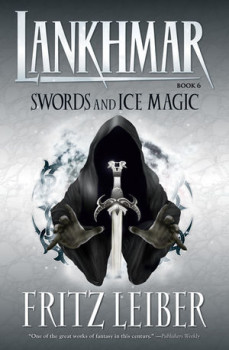 As I completed the series, I realized, in contrast to my initial reaction, that the language was one of the reasons why I love them. I understand that the Mouser is fashioned after Leiber’s own appearance and personality and that Fafhrd is modeled after Leiber’s good friend Harry Otto Fischer. One can imagine that, if Leiber and his friend were translated into a Sword and Sorcery world, then Leiber’s profound style as a writer easily could double as dirk and saber and thievish talents. In other words, Leiber writes with a rapier pen. So much of the pleasure in these tales isn’t about what happens – though there is pleasure to be had in that – but in the manner of the telling. If one only wants to know what happens in the stories, the language certainly is going to slow one down. But one should slow down. These stories are designed for the idle hours, for one who has idle hours, produced in an age in which one maybe had idle hours. Which perhaps is not how we’re used to reading stories now. These were probably written for an audience who considered reading the chief form of entertainment, who devoted time to it. Now reading seems to be something that so many do when there’s nothing else to do – like waiting in a dentist’s office or in a subway train.
As I completed the series, I realized, in contrast to my initial reaction, that the language was one of the reasons why I love them. I understand that the Mouser is fashioned after Leiber’s own appearance and personality and that Fafhrd is modeled after Leiber’s good friend Harry Otto Fischer. One can imagine that, if Leiber and his friend were translated into a Sword and Sorcery world, then Leiber’s profound style as a writer easily could double as dirk and saber and thievish talents. In other words, Leiber writes with a rapier pen. So much of the pleasure in these tales isn’t about what happens – though there is pleasure to be had in that – but in the manner of the telling. If one only wants to know what happens in the stories, the language certainly is going to slow one down. But one should slow down. These stories are designed for the idle hours, for one who has idle hours, produced in an age in which one maybe had idle hours. Which perhaps is not how we’re used to reading stories now. These were probably written for an audience who considered reading the chief form of entertainment, who devoted time to it. Now reading seems to be something that so many do when there’s nothing else to do – like waiting in a dentist’s office or in a subway train.
Another one of these stories’ chief qualities is just how satirical they are. I think that, above all, Leiber’s fantasy is satire. But his satire gets so confusing or understated because, even though he ‘s satirizing human behavior and sometimes the fantasy genre in general (at one point, after denoting something as gray, Leiber questions his spelling, parenthetically, by writing, “grey?”), his fantasy is so good. It’s good, foremost, because he adheres to the most necessary quality inherent in good fantasy. The “real” world feels very real. I am astounded by his details about the materials involved in the construction of his characters’ weapons. I am convinced by Leiber’s explanation of how crated goods are stowed in a ship to keep them from shifting. And Leiber applies this same intensity of detail to what isn’t real. In the construction of a Fafhrd and the Gray Mouser story, Leiber appears to thinks up a fancy, something that defies the laws of physics, and then he feels through, physically, what this violation of nature might mean. What I mean is that he doesn’t just think up a magical conceit and then allow it to be. He thinks up something that defies physics – like a stationary whirlpool in an ocean, for one story, or, for his last, what would happen if the Mouser suddenly got sucked down into the earth. And then he works through this conceit. In Leiber’s ultimate story, the Mouser gets sucked underground…and then just kind of finds himself there, hanging awkwardly amongst dirt and pebbles, quite some distance below the earth’s surface. Is the Mouser physical? If he is, can he breathe? Can he move? If so, what physical laws must be considered or altered and how? Leiber works out all this with incisive, magical detail.
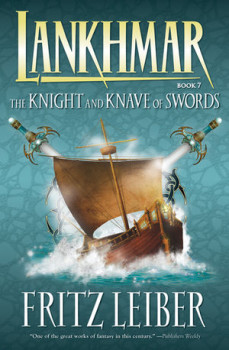 And he appears to have been thinking about these concepts for some time. Like Pratchett, who I am beginning to consider one of Leiber’s disciples, Leiber’s Sword and Sorcery yarns are laced with true metaphysical considerations, as if this science fiction writer was a little self-aware – perhaps even a mite embarrassed – to be writing fantasy, and wanted to give himself a little more justification. One of the most memorable tales – something that I still carry with me as if it were one of my own very vivid dreams – is when Fafhrd and the Mouser pass into our own world – some particular time in history in some European landscape, and Fafhrd and the Mouser become different people with different names and spend quite a number of years in our own world, even forgetting who they had been in Nehwon – until they find their way back, and then it as if their absence had been merely an odd vacation, and, once back in their proper world, our “real” world becomes their dream. Not only is this brilliant metaphysical commentary, but the “real” world, “our” world, is so amazingly detailed that it is clear that Leiber could be just as impressive at writing historical fiction. He seems to bring his characters into our cosmos partly as a way of showing off, but also as a way of demonstrating the mutability of the boundaries of the universes and the genres in which he could work.
And he appears to have been thinking about these concepts for some time. Like Pratchett, who I am beginning to consider one of Leiber’s disciples, Leiber’s Sword and Sorcery yarns are laced with true metaphysical considerations, as if this science fiction writer was a little self-aware – perhaps even a mite embarrassed – to be writing fantasy, and wanted to give himself a little more justification. One of the most memorable tales – something that I still carry with me as if it were one of my own very vivid dreams – is when Fafhrd and the Mouser pass into our own world – some particular time in history in some European landscape, and Fafhrd and the Mouser become different people with different names and spend quite a number of years in our own world, even forgetting who they had been in Nehwon – until they find their way back, and then it as if their absence had been merely an odd vacation, and, once back in their proper world, our “real” world becomes their dream. Not only is this brilliant metaphysical commentary, but the “real” world, “our” world, is so amazingly detailed that it is clear that Leiber could be just as impressive at writing historical fiction. He seems to bring his characters into our cosmos partly as a way of showing off, but also as a way of demonstrating the mutability of the boundaries of the universes and the genres in which he could work.
Another structure in Leiber’s fantasy is the duality of his heroes. If Howard established through his Conan yarns that the wandering hero should fight a sorcerous menace and also have an erotic dalliance, Leiber decided that he would double it. Leiber had two heroes, after all. Moreover, every aspect of his heroes is twofold, and there is seemingly no end to this doubling. If one hero has a girlfriend, so does the other. If one hero gets another girlfriend, so does the other. If one hero goes below, one goes above. If one follows a religion, so does the other. If one has a sorcerer as a mentor, so does the other. If one gets followers, so does the other, and their followers are almost exactly like their leaders, respectively.
Okay, I have given some high praise here. So what, possibly, can we expect Bailey to do with this material?
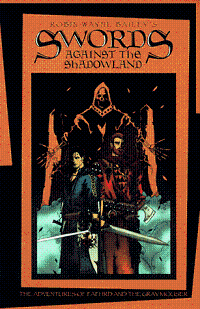 I was initially put off, settling back and opening Swords against the Shadowland, because, even though Dark Horse Books (and White Wolf before it) calls this “Book 8,” the last in the series, I had to quickly re-orient myself by discovering that it is what is called — according to Wikipedia — an “interpolation.” In other words, the events of this book happen earlier in the duo’s adventures, specifically right after the events of “Ill-Met in Lankhmar.” I was a touch disappointed. I had really begun to enjoy how the duo had aged, how they had grown scars, how they had had a few too many relationships (most of which ended badly or just weren’t right for them), and had apparently settled down with northern women who had similar feelings, who also had had a few too many relationships, who understood how these things realistically worked themselves out often in separation, and so all were involved in amicable, sexual understanding. (Clearly, this is reading material that my absolutist young boy brain would not have entertained too highly.) But I quickly forgave the interpolation, reflecting that any attempt to continue the Fafhrd and the Gray Mouser stories from this hoary height might be the summit of hubris indeed.
I was initially put off, settling back and opening Swords against the Shadowland, because, even though Dark Horse Books (and White Wolf before it) calls this “Book 8,” the last in the series, I had to quickly re-orient myself by discovering that it is what is called — according to Wikipedia — an “interpolation.” In other words, the events of this book happen earlier in the duo’s adventures, specifically right after the events of “Ill-Met in Lankhmar.” I was a touch disappointed. I had really begun to enjoy how the duo had aged, how they had grown scars, how they had had a few too many relationships (most of which ended badly or just weren’t right for them), and had apparently settled down with northern women who had similar feelings, who also had had a few too many relationships, who understood how these things realistically worked themselves out often in separation, and so all were involved in amicable, sexual understanding. (Clearly, this is reading material that my absolutist young boy brain would not have entertained too highly.) But I quickly forgave the interpolation, reflecting that any attempt to continue the Fafhrd and the Gray Mouser stories from this hoary height might be the summit of hubris indeed.
And then I read the first chapter, and then I thought that Bailey again was in danger of incurring the wrath of Godsland. Firstly this was because the introduction and establishment of Leiber’s characters seemed a bit heavy-handed, penned by Fafhrd’s broadsword, if you will, and not the Mouser’s rapier. And, granted, this can be a matter of taste. But, secondly, Bailey appeared to falter when he introduced Sheelba. There didn’t seem to be any forthcoming appearance of Ningauble, who would be Fafhrd’s sorcerous mentor (or the other way around, I keep getting the two mixed up).
But I finished the novel, of course, and I will go ahead and say that in every other instance Bailey conformed to the “rule of two.” So I wonder if there is some continuity reason for why Ningauble couldn’t make an appearance. True Leiber scholars are welcome to help me here.
The second chapter, “Sunlight and Shadows,” is where Bailey reveals his considerable talents. This is excellent stuff. Bailey adopts a fittingly Leiberesque style – if it doesn’t always ring true, well, who would be mad enough even to try this? Give him a break – and it is amazing that it even chimes most of the time. What’s more, Bailey may even have one-upped Leiber’s style, through Bailey’s frequent interjection of songs and poems – specifically, a truly funny, bawdy one from Fafhrd, and a truly gloomy and ominous one from Mou, the content of which clearly conforms to these two characters’ energies. That second chapter is one of the best things I’ve read in Sword and Sorcery, hands down, as the duo make their way into the Lankhmar whence they once fled in self-destructive despair.
I had thought perhaps there may not have been enough metaphysical ponderings – another ingredient in a proper Fafhrd and the Gray Mouser story – that was, until I reached the book’s resolution. And the final chapter, “Heroes’ Repose,” possibly rivals, for my affections, the second chapter. These characters very much feel like Leiber’s characters in Leiber’s world, not like someone else playing with Leiber’s toys and therefore making them speak in voices that are just plain wrong and putting them into incongruous situations. Most of all, with the sole exception of Ningauble’s absence, the structure is true. The doubling was here. If one got a woman – well, so did the other. If one got depressed, so did the other. If one took a piss, even. So. Did. The other. Fantastic stuff.
Many have made quite a bit of Leiber’s connection to the culture of Shakespearean actors, since both of his parents were these kinds of performers, and Bailey even seems to bring this out in his very last lines, four of which I shall share:
Your work is done, the tale is told,
And lives are saved a hundred-fold.
If only all man’s plagues could be
Such a neatly ended fantasy.
Finishing the book, and snooping around online, I find that I’m not the only one who loves this book so much. I see that it got a lot of attention when it was first published in 1998. I feel compelled to say here, though I know it’s possibly heresy to do so, that this might be my most favorite Fafhrd and the Gray Mouser story. Yes, that is heresy, you say? Well, how about this, then. It’s my favorite Fafhrd and the Gray Mouser novel (Leiber technically wrote only one Fafhrd and the Gray Mouser novel).
All this makes me want to read some more Robin Wayne Bailey. I’ll keep an eye out. I see that his stuff is not so readily available, though he contributed a number of tales to the Thieves’ World anthologies (yet another product that I should have been reading in my overly idealistic youth).
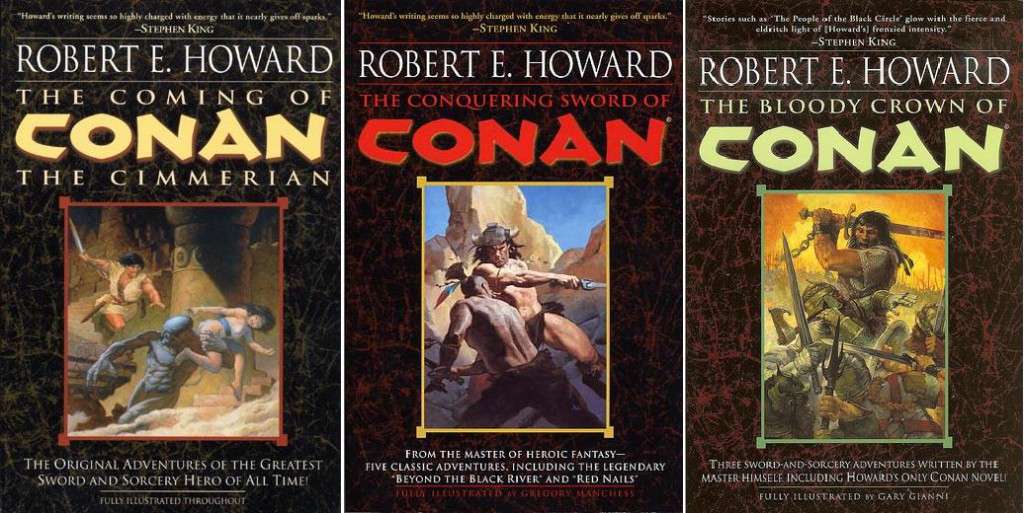
My oppinion of Leiber is quite ambigous. On the one hand, I think many of his stories are quite bad and silly. But on the other hand, most of his stories are really a lot of fun.
And man, those Conan book covers kick ass!
There’s an awful lot of Fafhrd and The Grey Mouser in Paul S Kemp’s two books (so far) featuring Egil & Nix.
Thanks for this. I’ve been curious about Mr. Bailey’s take on the character for years. It was written with the permission and even involvement of Leiber — if I recall, they had talked about it before Leiber’s death.
Incidentally, it was Fafhrd who was based off of Leiber’s looks, not the Mouser.
Thanks for the correction, Jones!
And I’ll look into Egil & Nix, Bob. The names certainly are reminiscent of Fafhrd (Norse) and, well, Latinate/Mediterrannean… 🙂
Shinder’s! Which one? I worked in their store in Bloomington, MN, back in 1990 (and, of course, signed over about 25% of my paycheck for stacks of employee-discounted books, comics and RPG stuff).
I do love those Mignola covers.
Sorry to sound pedantic: actually, Fisher was the Mouser and Leiber was Fafhrd
There’s a letter by Leiber, commenting on Fisher’s decision to leave fiction behind to start a packaging company, in which Leiber describes him as the Mouser, using cat’s Paw to spread glue on cardboard, and Scalpel to cut craft paper. Quite fun, as most of what Fritz Leiber wrote.
This doubling idea…Fafhrd and the Mouser are definitely the twentieth century prototypes, although I suppose the blood-brother fighting duo goes all the way back to Gilgamesh and Enkidu. Interesting to reflect on how many S&S characters post-Leiber are inspired by or even directly modeled on them (I’ve myself done so twice — once with the Monster Hunters, and then in a more parodic vein with Ququinn and the Ferret).
So this got me thinking…if doubling has become an overdone trope, how about the trio? We have precedent for that too, of course — going back to the Three Musketeers. With three, you must achieve a balance where you still have the feel of lifelong intimacy that one gets with kindred spirits like Fafhrd and the Mouser while avoiding it beginning to feel like you’re just creating a small campaign party.
So, those out there who are more well read in the genre than I: are there any notable trios in S&S or high fantasy that come to mind?
Joe, I’m an Eden Prairie kid. Shinder’s opened an outlet in a strip mall sort of thing that was pretty much in the parking lot of the Eden Prairie Center. That’s where I bought a lot of comics, roleplaying games (and, unfortunately, that’s where I SOLD a lot of my roleplaying games when my parents “made” me move the summer before my seventeenth birthday – I had given up being a nerd; it didn’t take), and wondered what was in that “back room.” 🙂
Davide, it looks like I won’t get anything past this crowd! 🙂 I’m about to start a series on Poul Anderson (beginning next Wednesday), and I’ll try to raise the fact-checking academic bar on that one. I’ve already got a stack of materials from my university library.
Nick, that tripling is precisely what I’ve been thinking! And that’s why I was asking you about Cross-Planes Riders (but any further comments here would threaten to alienate the rest of our present company). Dig out that old story!
Nick and Gabe, check out Sebastien de Castell’s Traitor’s Blade for trios and tripling. And for everything else you love in a story. It’s a stellar book, and my nomination for best novel of 2014.
Andre Norton’s last novel, Three Hands for Scorpio, was about triplet princesses. I hear she described it as her Charlie’s Angels novel. Haven’t read it myself, though.
[…] is impressive stuff. I liked it when Leiber really thought through his magical intrusions into his universe of Nehwon. Though Anderson’s […]
[…] is impressive stuff. I liked it when Leiber really thought through his magical intrusions into his universe of Nehwon. Though Anderson’s […]